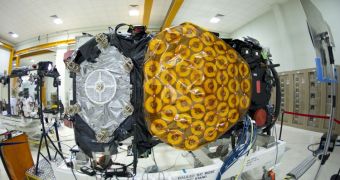Officials with the European Space Agency are proud to announce that the ESA Kourou Spaceport, in French Guiana, South America, has just received the first of many satellites that will form the Galileo satellite navigation system.
Meant as a counterpart to the American-built Global Positioning System (GPS), Galileo will feature numerous satellites that need to be built and launched over the next few years. The spacecraft that just arrived in the French Guiana is the first of them all.
At this point, preparations are on track for an October 20 launch date, from the specially-built Soyuz launch site at Kourou. The installation – built by engineers from the Russian Federal Space Agency under a contract with ESA – can launch Soyuz rockets and was opened earlier this year.
Tests have already confirmed that the facility is operational. Scientists here have yet to conduct a full dress rehearsal of the upcoming launch, but other than that everything appears to be in order.
The first Galileo In-Orbit Validation satellite, known as Flight Model 2 (FM2) arrived on the Cayenne Rochambeau Airport on September 7, aboard a massive Antonov aircraft. The transport began its long trek on Rome, where manufacturer Thales Alenia Space is based.
FM2 will soon be joined by yet another Galileo satellite, the Proto-Flight Model (PFM), in the coming days. Together, they will share the re-ignitable Fregat-MT upper stage of a Soyuz ST-B delivery system. ESA says that all spacecraft destined for this constellation will be launched in pairs.
“Final assembly of the three-stage Soyuz ST-B and the fuelling of the Fregat-MT upper stage will start next week, well in time for the launch date. October’s launch will be historic: the first Soyuz launch from a spaceport outside of Baikonur in Kazakhstan or Plesetsk in Russia,” an ESA statement says.
“French Guiana is much closer to the equator, so each launch will benefit from Earth’s spin, increasing the maximum payload into geostationary transfer orbit from 1.7 tonnes to 3 tonnes,” the agency's press release adds.
Rather than haul its spacecraft all over the world in search for a launch site and rockets, ESA decided that it was a lot cheaper and more convenient to have an entire launch pad for the medium-class Soyuz rockets built in Kourou. This allows the agency to deploy Galileo on its own terms.
“As a medium-class launcher, Soyuz will complement Ariane and Vega to increase the flexibility and competitiveness of Europe’s launcher family,” the ESA statement explains. It concludes by saying that Galileo will be made up of 30 satellites, of which the first four will launch in 2011 and early 2012.

 14 DAY TRIAL //
14 DAY TRIAL //